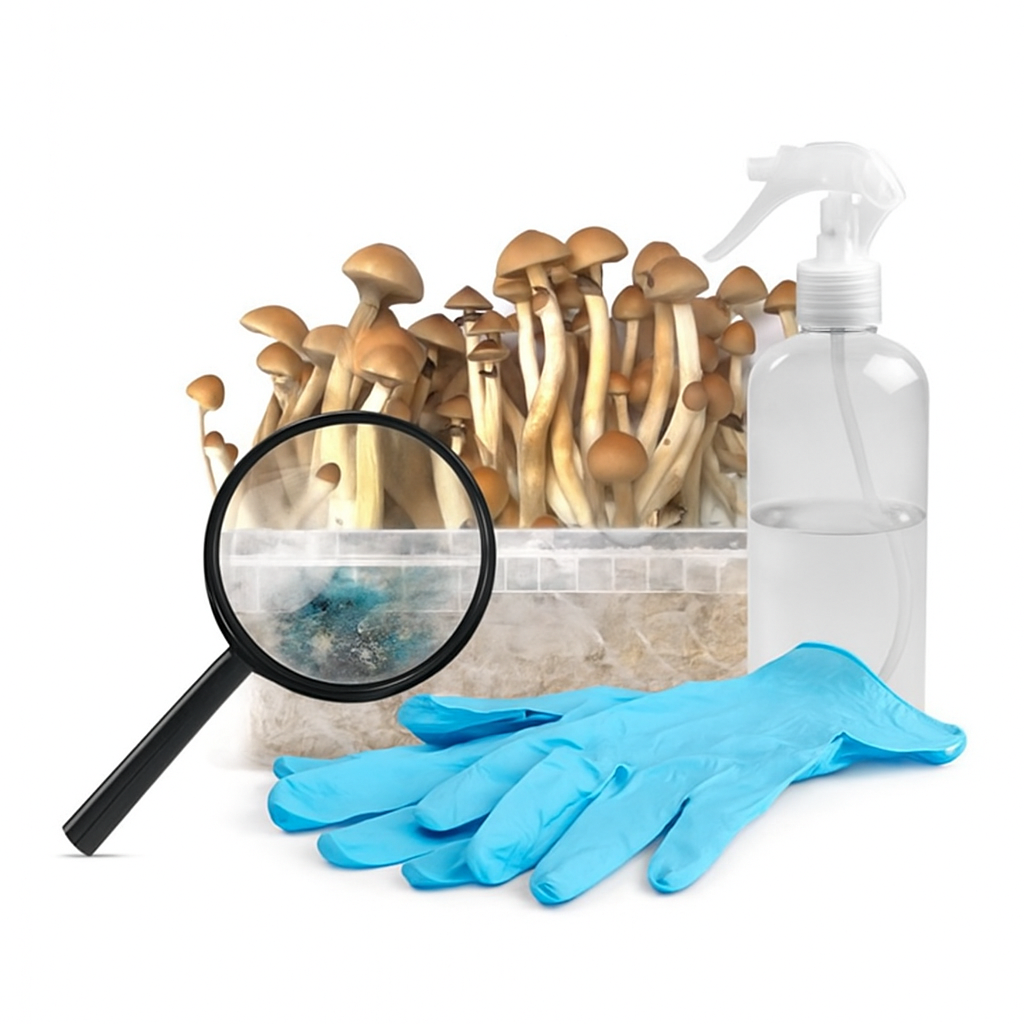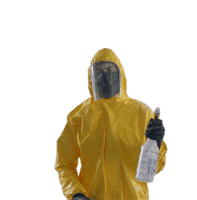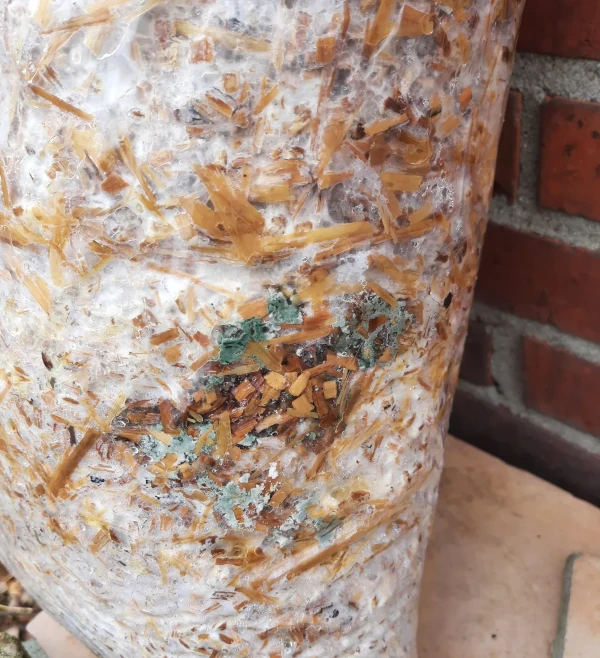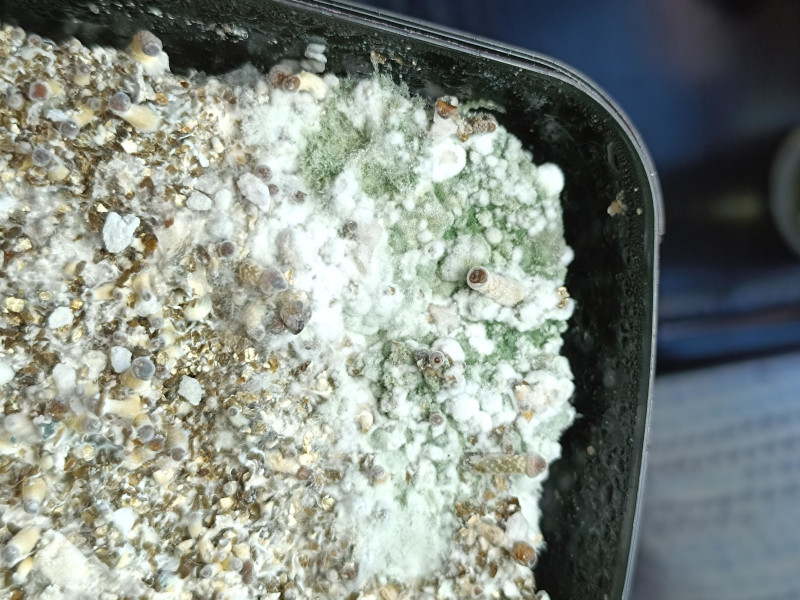How to prevent and treat contamination in mushroom cultivation
- How to prevent contamination in mushroom cultivation
- Working in a clean environment
- Sterilization of substrate, materials, and utensils
- Safe handling of cake and substrate
- Environmental control: temperature, humidity, and ventilation
- Hygienic manipulation throughout the process
- How to identify contamination in mushroom cultivation
- Visual signs of contamination in mycelium
- Odors that alert to infection
- Types of contamination in mushroom cultivation
- Opportunistic bacteria
- Contaminating molds
- Yeasts and pseudomonas
- Mites and microscopic pests
- Summary table of common contaminants in mushroom cultivation
- Treatment of contamination in mushroom cultivation
- Initial evaluation
- Removal of contaminated areas
- Treatments according to contamination type
- Cleaning and prevention of recontamination
- When to discard cultivation without attempting rescue?
Mushroom cultivation —whether edible, medicinal, or magic— requires hygiene, precision, and close attention to detail. One of the greatest challenges for any cultivator is keeping the cultivation free from contamination: a single oversight is enough to ruin the harvest and compromise the safety of those who consume it.
The main contaminating agents are usually competing fungi and bacteria that affect mycelium health and alter the growing environment. In this article, we explain how to prevent, identify, and treat the different forms of contamination that can appear during mushroom cultivation.
How to prevent contamination in mushroom cultivation
The most effective way to avoid contamination is to prevent its occurrence from the beginning of the process. Prevention is the key to maintaining a clean, stable, and safe environment where mycelium can develop without interference. Below, we show you the essential factors you must consider to minimize risks.

Working in a clean environment
Cleanliness of the workspace is fundamental. Before handling any element (cake, substrate, tools), make sure to thoroughly disinfect all surfaces, including walls and floor if working in an enclosed space.
- Use 70% isopropyl alcohol or disinfectants suitable for mushroom cultivation.
- Avoid air currents that may introduce contaminating spores from outside.
- Whenever possible, work in an enclosed environment with controlled ventilation or inside a sterile cultivation box (glovebox).
- For greater efficiency, you can complement cleaning with home sterilization kits or UV-C lamps, which help reduce microbial load in the air and surfaces before starting manipulation.
Cross-contamination can come even from clothing, breath, or airborne particles, which is why wearing a mask is recommended if the environment is not controlled.
Sterilization of substrate, materials, and utensils
The substrate and all equipment that comes into contact with mycelium must be properly sterilized. This step is critical, especially if you prepare the materials yourself.
- Substrate: whether grain, sawdust, vermiculite, or other mixtures, it must undergo a sterilization or pasteurization process that eliminates bacteria, molds, and spores. You can use pressure cookers (at 15 psi for at least 90 minutes) or, if you have access, an autoclave.
- Containers: jars, bags, and trays must be thoroughly cleaned and preferably sterilized with heat or disinfected with alcohol.
- Inoculation utensils: if using spore syringes or liquid mycelium, flame the needle before each use and always work under sterile conditions. This step is crucial to prevent contamination from the start.
Safe handling of cake and substrate
The substrate is a very nutritious medium, both for mycelium and contaminating microorganisms. To reduce risks:
- Don't remove the protective film from the cake until the exact moment of starting cultivation.
- Use gloves and avoid touching the substrate directly with your hands.
- If you notice unpleasant odors, excess moisture, or anomalous compaction before starting, consider not using that cake.
Environmental control: temperature, humidity, and ventilation
Inadequate environmental conditions can weaken mycelium and favor the appearance of contaminants. Maintain stable temperature between 20°C and 26°C during the incubation phase (according to the cultivated species).
Relative humidity must be well controlled: if excessive, it can favor mold development. Control humidity with a hygrometer and ventilate moderately. Ventilation should renew air regularly but without generating abrupt currents, as both stagnant air and excessive flow can harm cultivation.
Hygienic manipulation throughout the process
Every time you manipulate the cultivation, a window opens for possible contamination. To minimize risks:
- Wash your hands thoroughly before starting.
- Always use disinfected gloves and, if possible, a mask.
- Meticulously disinfect all tools (knives, tweezers, sprayers) before each use.
- Avoid talking, breathing directly, or sneezing over the cake or substrate while working.

How to identify contamination in mushroom cultivation
Detecting contamination in time can make the difference between saving or losing your cultivation. That's why it's essential to pay attention to three key indicators: changes in mycelium appearance, unusual odors, and developmental alterations. These signals can alert you to the presence of contaminating fungi, bacteria, or molds before they spread.
Visual signs of contamination in mycelium
Direct observation is one of the most effective tools. Regularly check your cakes or jars for warning signs:
- Color stains: green, blue, black, pink, orange, or yellow. They usually indicate the presence of contaminating molds or yeasts.
- Abnormal textures: slimy, cottony, spongy, or powdery-looking areas.
- Stopped or uneven growth: mycelium stops expanding, weakens, or shows dull areas.
- Mushroom malformations: deformed fruiting bodies or complete absence of fruiting.
- Areas affected by extreme humidity or dryness: waterlogged, dry, or withered areas without apparent reason.
- Anomalous crystallization or presence of residues on the jar surface can also be signs of problems.

Odors that alert to infection
Smell can be a great ally, especially against bacterial contamination. If you detect any of these odors, it's time to act:
- Sour, acidic, or vinegary smell: typical of bacterial infections or unwanted fermentation.
- Ammonia or putrefaction smell: indicates decomposition or serious contamination.
Types of contamination in mushroom cultivation
There are different forms of contamination that can affect mycelium development and compromise the entire cultivation. Recognizing them in time is essential to know how to act. Below, we describe the most common contaminants in mushroom cultivation:
Opportunistic bacteria
Bacterial contaminations usually manifest as slimy, wet areas with bad smell (sour, ammoniacal, or rotten). These infections proliferate rapidly if humidity is not controlled or if the cultivation environment lacks hygiene.
- Bacillus spp. (known as Wet Spot or Sour Rot) is common in poorly prepared grain jars. It forms a grayish and slimy mass with strong odor. It's due to heat-resistant spores that survive sterilization.
- Pseudomonas tolaasii (bacterial blotch) produces yellow or brown spots on cap edges when they remain wet after watering. It's transmitted by airborne particles.
Contaminating molds
Competing fungi are one of the most frequent threats in mushroom cultivation. Their spores are present in the environment and can colonize the substrate if they find favorable conditions.
- Trichoderma harzianum: starts white and turns intense green when mature. It's one of the most aggressive and difficult to control molds. It can form a bright white ring around the colony and emit a sweet coconut-like smell.
- Penicillium spp.: blue-greenish appearance and powdery texture. Its growth is usually fast and spreads easily through air. It usually appears first as white colonies, which can make detection difficult.
- Aspergillus spp.: appears as black, gray, or green spots. Some strains produce mycotoxins and their spores can be dangerous when inhaled. They may have a musty or oily smell.
- Chaetomium spp.: olive green color, common in poorly composted substrates. Usually appears in prolonged humidity conditions.
- Geotrichum spp.: evolves from white to red or orange. It's less aggressive, but can compromise cultivation aesthetics and healthiness.
- Scopulariopsis / Gliocladium spp. (Lipstick mold): changes from white to pink, red, and dull orange. Colonizes compost and can be transmitted through air or irrigation. Grows slowly but is persistent.
- Neurospora spp. (Pink mold): appears as bright pink mold. It's very invasive and difficult to eradicate, as it penetrates plugs and filters.
- Rhizopus spp. (Pin mold): forms elevated structures with black spores. It's very fast and common in grain or straw.
- Verticillium fungicola (Dry bubble): deforms primordia and mature mushrooms, causing gray or brown surface lesions. Spores are sticky and spread through air or contact.
- Dactylium mildew (cobweb mold): develops at great speed and can cover the entire kit in 24 hours. It looks like cottony mycelium that causes soft rot in mushrooms.

Yeasts and pseudomonas
Less visible than molds, but equally undesirable, these infections especially affect the final product:
- Deteriorate mushroom quality, altering their color, texture, and smell.
- Produce toxins or irritating substances in mycelium and fruiting bodies.
- Usually appear when there's poor ventilation and excessive humidity.
Mites and microscopic pests
Some mites can coexist without harming cultivation, but others feed on mycelium, accelerate decomposition, or act as contaminant vectors. Their presence usually indicates lack of cleanliness or unbalanced environmental conditions.
Substrate gnats (fungus gnats): small insects that lay eggs in the substrate. Larvae dig tunnels in mushrooms and spread bacteria that cause soft rot. They usually appear in very humid and poorly ventilated environments. Their control requires constant vigilance, sticky traps, and improvement of cultivation conditions.
Summary table of common contaminants in mushroom cultivation
| Contaminant | Appearance | Main cause | Risk | Recommended action |
|---|---|---|---|---|
| Trichoderma harzianum | Cottony white → intense green | High humidity, airborne spores | Very high | Discard entire cultivation |
| Penicillium spp. | Blue-greenish, powdery | Contaminated air, poor ventilation | Medium-high | Improve aeration, possible discard |
| Aspergillus spp. | Black, gray or green, with white halo | Humidity + lack of hygiene | High | Discard and thoroughly disinfect |
| Chaetomium spp. | Olive green, with brown tones | Poorly composted substrate | Medium | Extract area and monitor |
| Geotrichum spp. | White → pink or orange | Insufficient ventilation | Low-medium | Monitor or trim area |
| Lipstick mold | White → pink, red, orange | Airborne spores, irrigation | Medium | Improve hygiene, trim area |
| Pink mold (Neurospora) | Bright pink | Cross-contamination, poor sealing | High | Remove cultivation and disinfect |
| Pin mold (Rhizopus) | Tall hyphae with black spores | High humidity, carbohydrate presence | High | Remove cultivation, deep cleaning |
| Dry bubble (Verticillium) | Deformed mushrooms, gray spots | Sticky spores, insects | Medium-high | Remove affected mushrooms, salt on paper |
| Dactylium mildew | Cottony white cobweb-type | High humidity, poor ventilation | High | Reduce humidity, remove affected area |
| Bacteria | Slimy, wet areas, bad smell | Excess humidity, dirty utensils | High | Reduce humidity, treat with chlorine |
| Pseudomonas spp. | Gray spots, discolored mushrooms | Warm and closed environment | Medium | Improve aeration, possible discard |
| Yeasts | Whitish film, sour smell | Condensation, cross-contamination | Low-medium | Adjust humidity and cleanliness |
| Mites | Moving dots, crumbled substrate | Lack of hygiene, contaminated materials | Variable | Complete disinfection, biological control |
| Substrate gnats | Visible larvae, mushroom damage | High humidity, unprotected compost | High | Biological control, ventilation and cleaning |
Treatment of contamination in mushroom cultivation
You've detected contamination in your mushroom cultivation. Although the safest approach —and what most experienced cultivators recommend— is to completely discard the affected cultivation, in some mild cases it's possible to attempt a rescue. However: never try to save a cultivation with toxic molds, extensive contamination, or bad smell. When in doubt, it's best to discard and start over under optimal conditions.
Initial evaluation
Before acting, perform a quick but precise evaluation:
- Identify the type of contaminant: is it mold, bacteria, or yeast? What color and texture?
- Assess the extent of damage: does it affect a small localized area or has it spread?
- Determine if rescue is viable: if healthy mycelium remains active, a targeted treatment can be attempted.
Removal of contaminated areas
If contamination is mild and localized, you can try to remove it with extreme precautions:
- Always use clean gloves and sterilized knife.
- Carefully cut out the contaminated area, without touching healthy mycelium.
- Sprinkle a thin layer of sea salt over the "wounded" area: this helps slow the advance of bacteria or surface molds.
- Disinfect knife and tools after each cut to avoid spreading contamination.
Treatments according to contamination type
Trichoderma (green mold)
This fungus is extremely aggressive and can colonize the entire cultivation in a few hours. The safest and recommended option is to completely discard the affected kit, even if it only shows symptoms in a small area, as spores may have dispersed without being visible.
If you decide to try rescuing the cultivation, do so as an exceptional measure with extreme caution. Use a sterilized spoon or spatula disinfected with isopropyl alcohol to remove the contaminated area, leaving a minimum 1 cm margin around the visible mold. Next, you can spray the area with 10-volume hydrogen peroxide (3%) to try to destroy residual spores, although this doesn't guarantee complete elimination.
This procedure can be repeated, but must always be performed outside the cultivation area to prevent spores from dispersing and contaminating other kits. It's also recommended to ventilate and disinfect the room after handling infected cultivations.
Bacterial contamination (sour smell, slimy or decomposed areas)
Minimize environmental humidity and improve ventilation of the environment. Carefully apply a solution of chlorine diluted to 150 ppm (about 5 drops of common bleach per 100 ml of water) over the affected area, avoiding direct contact with healthy mycelium. You can also use sterile absorbent paper to remove excess moisture before applying the disinfectant.
Doubtful white fuzz
Sometimes, aerial mycelium can be confused with contaminating molds. Observe its smell, texture, and growth speed:
- If the smell is neutral or pleasant, and texture is fine and uniform, it's probably healthy mycelium.
- If it's very fluffy, grows unusually fast, has bad smell, or acquires grayish tones, it could be cobweb mold (Dactylium) or other contamination. In this case, act quickly by removing the affected area and applying 10-volume hydrogen peroxide, as with Trichoderma.
Cleaning and prevention of recontamination
After performing any treatment, it's crucial to reinforce hygiene to prevent outbreaks:
- Disinfect the cultivation space (surfaces, tools, nearby environment).
- Review and adjust environmental conditions: excess humidity or poor ventilation are usually behind most contaminations.
- Apply mild disinfectant solutions like 3% hydrogen peroxide, isopropyl alcohol, or diluted chlorine on surfaces (never directly on mycelium except specific indication).
When to discard cultivation without attempting rescue?
For safety and effectiveness, it's recommended to discard the cake or cultivation jar in the following cases:
- Visible contamination in more than 30% of the cake or substrate.
- Confirmed presence of potentially toxic molds: like black Aspergillus or extensively spread Trichoderma.
- Putrid or chemical smell, indicative of serious bacterial infection.
- Complete lack of response after treatment and continuous mycelium deterioration.
In these cases, discard the contents with caution, clean the work area well, and make sure to start the next cultivation with controlled conditions and sterile materials.
Contamination in mushroom cultivation is a constant but controllable risk. The key lies in rigorous hygiene, constant monitoring, and quick action at the first signs.
Adopting preventive protocols, educating yourself about contaminants, and observing cultivation daily are the most effective tools to maintain a healthy and productive harvest.
Successfully cultivating mushrooms is not just about technique, but also about developing an attentive relationship with mycelium. Each mistake teaches, each harvest strengthens. Cultivation is also a constant learning process.
Sources
- https://www.shroomery.org/8422/Sterilization-Tips
- https://www.reddit.com/r/shrooms/comments/ervxh8/is_that_contam_identification_avoidance/
- https://northspore.com/blogs/the-black-trumpet/common-contamination-in-mushroom-cultivation?srsltid=AfmBOopZpjTTfJUxs-cChHOM41pFCgG8SIwM6mNhSpBl2FsO4kRJdmed&utm_source=chatgpt.com
- https://mycodelic.cl
- https://www.shroomery.org/5276/What-are-common-contaminants-of-the-mushroom-culture




















